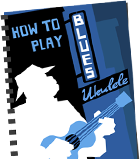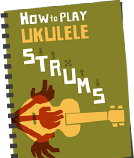A guest post today from Joshua Waldman. As well as leading the Tigard Ukulele Group he has just released a book How to Start and Grow a Ukulele Group (available in digital and paper form (affiliate links)). It’s by far the most comprehensive and inspiring I know of. Highly recommended if you’re starting or running a ukulele group.
When I started the Tigard Ukulele Group (TUG), I had no interest in leadership. I work for myself in a home office. My business is online and I don’t have a team to manage, nor do I have a boss to worry about. I’m not trying to be a better boss or climb some corporate ladder. What does leadership have to do with me?
Turns out, I found an answer to that question very quickly! Running an ukulele group has been one of the greatest personal growth journeys I’ve ever undertaken.
What I learned is that being a leader requires you to find your self-confidence, own the room, make decisions and take risks. It also means potentially making public mistakes and embarrassing yourself. But it also means being someone that others can rely on, being the beacon that guides people, of taking the initiative on fun and inspiring projects.
You make the call
When I first started TUG, we went around in a song circle. Everyone brought their own songs and some extra copies to pass around. This worked fine for the first few weeks and when we had around seven people in my living room. However, as we grew, the song circle format fell apart. Songs bombed. We ran out of music to play.
So the next time we met, I told them what we were playing. “Here’s our song list.” I remember feeling totally surprised that everyone agreed to this. Looking back, this makes sense, they came to play music, not lead a group. That was my job. Even now, at potlucks and parties, when I ask the group what they want to play they look back at me and say, you tell us, we’ll follow.
A few years ago, we were preparing for our very first concert and used our jam sessions to practice songs on our setlist. Our focus was to get into songs and out of songs at the same time. For weeks, we played the same songs over and over again. The concert happened. It went great! And I kept up the practice of repeating songs that needed more work.
After a while of this new format, I checked in with the group to see if they were getting tired of this. To my surprise, everyone really appreciated it. This format continued naturally, even after the concert. In fact, to this day, if a song could have gone better, and I’m about to flip to the next one, members will ask to repeat it, “just one more time.”
You are the leader of your group. You make the calls. Stop looking for approval or consensus. It’s not you imposing your will on others. It’s you offering others the chance to relax and just follow along. Leadership is service to others.
Own your mistakes
We were working on a difficult and highly orchestrated song at TUG one time when a longtime member who hadn’t been for a while showed up. She hadn’t been there the previous two weeks while we were working on this. When she raised her hand and offered some suggestions that would have radically changed what we’d been doing for weeks, I shut her down. “It is the way it is. No more changes,” I said and then watched as she shut down, stopped playing and her body folded in on itself.
I immediately realized my mistake, having gotten so intensely focused on getting the song right that I forgot that we were there to have fun! After the session, I went up to her and apologized. Although she shook it off, said it was no problem and changed the subject, I could tell she appreciated the apology.
Leadership isn’t always easy. But it does make you a better human being as long as you learn from your mistakes.
What I learned from leadership
What I learned is that leadership is a very personal journey. It’s a mirror for your own limiting beliefs, low self-esteem, self-doubt and fears. One of the greatest benefits of having started this group has been the chance to face these parts of myself and deal with them and then grow as a person.
Leadership is an interesting thing. In an age that seems to value collaboration and groupthink as ultimate ideals, apparent leadership seems to be based on how rich you are or how many likes you get on social media posts. I think this is a sad waste. Everyone has leadership potential. Despite our media, human nature is human nature, and groups of humans seek out a leader to represent them. The world isn’t run on consensus or on who has the most likes.
Joshua Waldman is the founder of Tigard Ukulele Group and had just published a book called, How to Start an Ukulele Group where you can find more stories and thoughts on ukulele group leadership.




